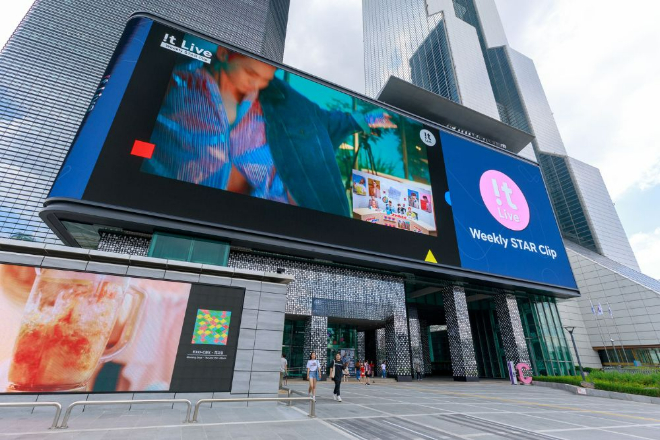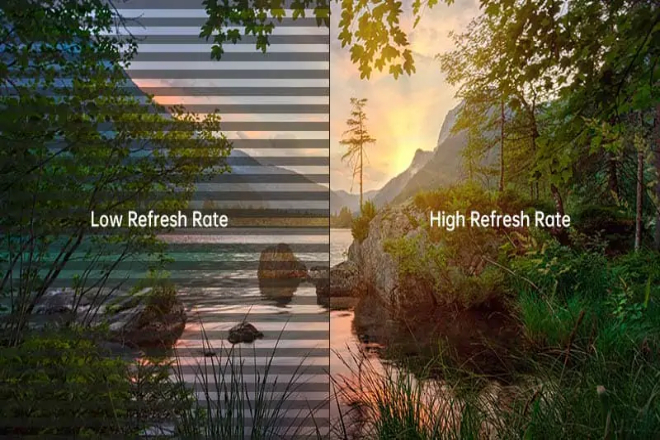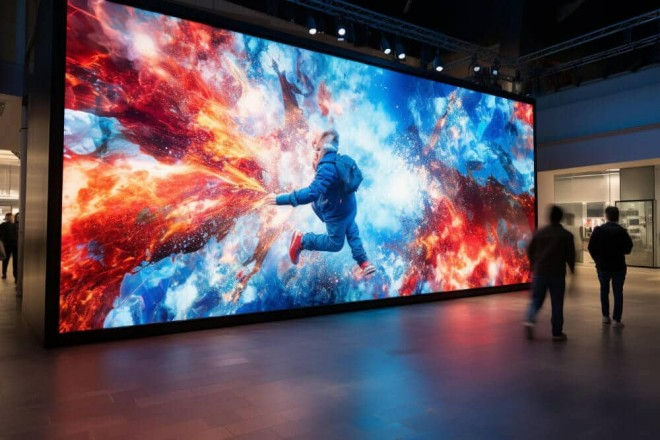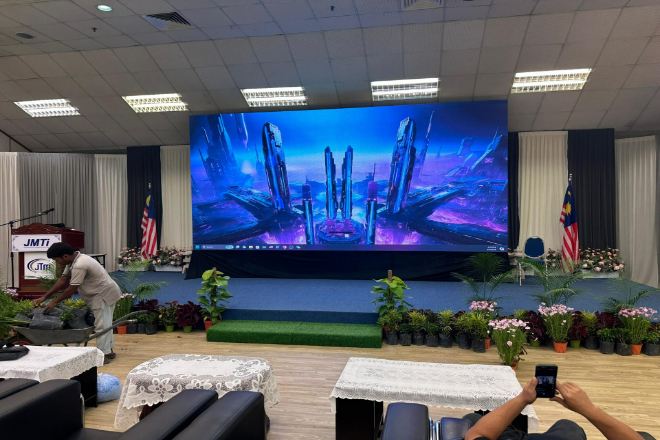介绍

刷新率作为显示技术的重要组成部分,一直是消费者和厂商比较关注的方面。
因为它直接关系到画面的流畅度和清晰度 LED显示屏那么,有人会问:刷新率越高,LED显示屏的显示效果就越好吗?
其实答案并不全是高刷新率带来的清晰度和流畅度,具体原因还请看文章。
1、LED显示屏的刷新率是多少?

说到 刷新率,其实挺简单的,就是屏幕每秒刷新多少次,单位用赫兹(Hz)来表示。想象一下,你正盯着一块LED显示屏,上面的画面并不是静态的,而是不断刷新更新的。
如果刷新率为60Hz,就意味着屏幕每秒钟会刷新60次。也就是说,你眼睛所看到的画面,每秒钟都会有60次新的面貌。
刷新率参数对LED显示屏的显示效果影响很大。
首先,刷新率越高,画面更新越频繁。 这就好比看电影一样,如果电影的帧率低,画面就会卡住,不流畅。
但如果帧率高的话,画面就会如丝般顺滑,看起来很舒服。LED显示屏也是如此。刷新率高的话,动态内容显示会更流畅,不会有拖影、卡顿的感觉。
再说一下图片的残像。 有时,当你观看快速移动的物体,例如赛车游戏或动作电影时,你可能会发现屏幕上有一个微弱的阴影跟随移动的物体。
这是因为刷新率不够高,屏幕更新速度跟不上运动速度。但如果刷新率高了,这种残影就会大大减少甚至消失,让你看得更清楚,更过瘾。
2、LED显示屏高刷新率的优势
1). 更流畅的动态画面表现
对于LED显示屏来说,高刷新率最直观的好处就是可以更加流畅的显示快速移动的画面。想象一下,你正在观看一场精彩的体育赛事,球员们在赛场上飞速奔跑,皮球在空中划出优美的弧线。
如果显示器的刷新率不够高,这些快速移动的画面可能会出现拖影或模糊,让您难以清晰捕捉每一个精彩瞬间。但是,有了高刷新率,这些问题就迎刃而解了。
无论是体育赛事、游戏,还是其他快速变化的场景,高刷新率都能保证画面流畅、通畅,让你仿佛身临其境,感受到每一个细节的震撼。
2).减轻视觉疲劳,保护眼睛健康
长时间注视屏幕,眼睛容易疲劳,尤其是屏幕刷新率较低时,画面闪烁明显,高刷新率LED显示屏可以有效减轻这种视觉疲劳。
因为高刷新率意味着屏幕图像被频繁刷新,每次刷新都是对图像进行微小的调整,这样眼睛看到的画面会更加稳定,减少图像闪烁带来的刺激。因此,如果你工作或者娱乐需要长时间面对屏幕,选择高刷新率的LED显示屏无疑是对眼睛的一种关爱。
3). 提高色彩和亮度均匀性,创造更自然的画面
高刷新率除了带来流畅度、减少视觉疲劳之外,还有助于提高LED显示屏色彩和亮度的均匀性。
在某些特定情况下,例如显示复杂色彩或者高亮度图像时,高刷新率可以更准确地还原色彩和亮度信息,使画面看起来更加自然逼真。
因为高刷新率可以更快的响应画面的变化,减少色彩和亮度的延迟和偏差。所以如果你对画面的色彩和亮度有很高的要求,那么选择高刷新率的LED显示屏绝对会让你的视觉体验更上一层楼。
4). 拍照效果好
你要知道刷新率就是屏幕每秒更新画面的次数,刷新率越高,画面更新越快,看上去就越流畅。当你用相机或者手机拍摄LED显示屏的时候,如果刷新率不够高,拍出来的照片可能会有水波纹或者闪烁的情况,看上去就不舒服。
而高刷新率的LED显示屏可以很好的解决这个问题,因为它的画面更新速度非常快,你的相机或者手机的快门几乎捕捉不到画面变化的痕迹,所以拍出的照片会非常清晰、稳定,不会出现水波纹、闪烁的现象。
3. LED显示屏高刷新率不具有绝对优势的场合

1). 内容类型:
当我们谈论 LED 显示屏的高刷新率时,我们常常会想到它如何使快速移动的画面变得更加流畅。
不过,并不是所有的内容都需要高刷新率才能发挥出最佳效果,对于静态的画面,或者变化很慢的场景,比如展示一幅画,播放一段慢动作视频,高刷新率的优势就没那么明显了。
因为这些内容本身变化不大,所以即便刷新率很高,也无法带来明显的视觉提升。
所以,在选择LED显示屏的时候,一定要根据显示内容来判断是否需要高刷新率,避免盲目追求高参数,浪费资源。
2). 观看距离 和解决方案:
另外需要考虑的因素就是观看距离和分辨率,如果我们站的距离比较远看LED显示屏,或者显示屏本身的分辨率就不高,那么即使刷新率很高,我们也不一定能感受到画面流畅度的明显提升。
因为两种情况下,我们的眼睛都无法捕捉到屏幕上细微的变化,高刷新率带来的优势就被削弱了。
因此我们在选择LED显示屏的时候还要结合我们的观看距离以及分辨率的要求来考虑刷新率的选择。
3). 成本和 能量消耗:
最后不得不提成本和功耗问题,高刷新率的LED显示屏往往意味着更高的制造成本和更大的能耗。
要实现高刷新率,需要更先进的驱动技术和更优质的元器件,这会增加制造成本。同时,高刷新率也意味着屏幕需要更频繁地刷新画面,从而消耗更多的电量。
所以我们在选择LED显示屏的时候,也需要权衡性价比,根据自己的预算和使用需求选择合适的刷新率,不要一味追求高刷新率而忽略了成本和功耗问题。
4、刷新率与LED显示屏其他参数的协同作用
LED显示屏的性能不仅仅取决于刷新率,而是多个参数的协同作用。接下来,我们来探讨一下刷新率与LED显示屏其他参数之间的协同作用。
1). 灰度和色深
高刷新率虽然能带来更加流畅的画面,但要充分发挥其优势,还需要搭配足够的灰度和色深,灰度是指LED显示屏在不同亮度下能够分辨的颜色数量。
灰度越高,色彩越丰富,颜色越鲜艳。色深是指显示器能够显示的颜色数量,色深越高,画面越细腻逼真。
如果仅有较高的刷新率而没有足够的灰阶和色深,画面可能会出现色彩不连续、过渡不自然等问题,从而影响整体的视觉体验。
因此,在选择LED显示屏的时候,我们不仅要关注刷新率,还要注意灰度和色深两个参数,保证它们能够互相协调,共同呈现出高质量的画面。
2). 对比与 亮度
良好的对比度和亮度是保证高刷新率下画质的基础。对比度是指显示图像时最亮区域与最暗区域的比值。对比度越高,图像的层次感越强,色彩越鲜艳。
亮度是指屏幕显示的光线强度,亮度越高,画面越明亮清晰,如果对比度和亮度不足,即使刷新率很高,也会出现画面模糊、暗淡等问题。
特别是在一些高刷新率的应用场景,例如体育赛事直播、游戏比赛等,画面变化迅速、复杂,需要良好的对比度和亮度来保证画面的清晰度和色彩还原。
因此,在选择LED显示屏的时候,一定要综合考虑刷新率、对比度、亮度三个参数,保证画质满足实际需要。
3).驱动技术及控制系统
先进的驱动技术和控制系统保证高刷新率下的稳定运行。
驱动技术是指LED显示屏内部控制LED灯珠发光的技术,它直接影响显示屏的刷新率、灰度等级、色深等参数。
先进的驱动技术可以提供更精确的控制和更快的响应速度,从而保证高刷新率下画面的稳定性和流畅度。
控制系统是指用于管理和控制LED显示屏显示内容的软件或硬件系统。
优秀的控制系统可以提供更加丰富的功能、更加便捷的操作、更加稳定的性能,从而进一步提升显示效果和用户体验。
因此,在选择LED显示屏时,不仅要关注刷新率等硬件参数,还要关注驱动技术、控制系统等软件参数,确保它们能够相互协调,共同提高显示屏的整体性能。
同时,随着技术的不断进步和应用需求的不断增加,我们也应关注新技术的发展,及时了解和应用最新的驱动技术和控制系统,以提升LED显示屏的显示效果和用户体验。
5、实际应用中选择LED显示屏的建议

在选择LED显示屏的时候,刷新率是一个非常重要的指标,但是只看刷新率是不够的,还要综合考虑其他因素,这里给大家一些比较实用的选择建议。
1).根据需要选择刷新率
- 看看使用场景:
你要想好这个LED显示屏用在什么地方,比如直播间,会议室等经常拍照,拍视频的地方,刷新率要高一些,最好是3840Hz以上,这样拍出来的画面才清晰,才不会有水波纹。
如果只是放在户外当广告牌的话,刷新率就不需要太高,960hz或者1920Hz都可以,毕竟没人会靠那么近去看。
- 考虑观看需求:
您还必须考虑观看者距离屏幕有多远以及从哪个角度观看。如果观看者距离屏幕很近或者角度有变化,则刷新率应该更高,以使其看起来更舒适。
2).综合考虑性价比,不要只看刷新率
- 计算成本:
高刷新率意味着昂贵,这是大家都知道的。所以,选择的时候,一定要掂量一下自己的钱包,不要为了追求刷新率而牺牲其他重要参数。
- 看看耗电量:
高刷新率也意味着耗电,长远来看,电费也是一笔不小的开支,所以选择的时候一定要看能效等级,选择既符合需求又省电的。
- 比较综合性能:
在选择LED显示屏的时候不要只看刷新率,还要看灰度等级、色深、对比度、亮度,灰度等级和色深决定了画面是否细腻,色彩是否准确。
对比度和亮度决定了画面是否清晰明亮,还有驱动技术、控制系统等,这些都影响着画面的稳定和流畅度,所以选择的时候要综合考虑,不要有失偏颇。
3). 参考专业评论和用户反馈以获得更好的想法
- 看看专业评论:
网上有很多专业机构和媒体对LED显示屏的评测,非常详细客观,选择之前可以先看看这些评测,了解不同品牌、不同型号的性能,心中就会有个大概。
- 听听用户的评价:
除了专业评论,还可以看看其他用户的反馈。用户的反馈是最真实的,用过之后才知道好不好。可以在电商平台、社交媒体上寻找,了解其他用户的购买和使用体验。
- 亲自去体验一下:
如果条件允许,最好能去实体店或者展厅亲自看实物,看看画面效果怎么样,操作起来是否方便,这样选择的LED显示屏才会最符合你的需求。
结论
综上所述,刷新率作为LED显示屏的重要参数之一,对显示效果确实有着不小的影响。
高刷新率可以带来更加流畅的动态画面表现,减少视觉疲劳,在某些情况下还可以提高色彩和亮度的均匀性,但刷新率也不是越高越好。
在不同的内容类型、观看距离、分辨率下,其优势可能并不明显,还会增加成本和功耗。
最后,如果您想了解更多关于LED显示屏的知识, 请与我们联系。
